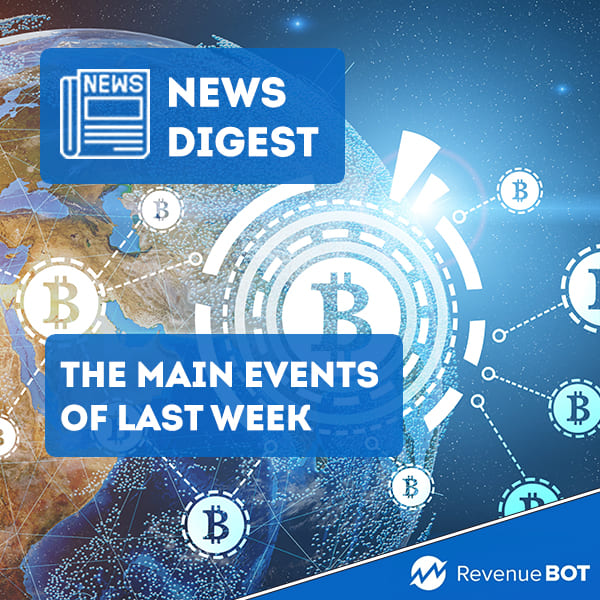
Friday, 24th of March. As the week comes to an end, we can focus on the highlights of the crypto industry for the past few days.
Glassnode: banking crisis pushes BTC out of bear market
Bitcoin saw an impressive weekly gain of 35.8% due to emergency measures taken by leading central banks after confidence in banks was eroded. There appeared some kind of structure on digital gold, reminiscent of earlier bull markets in the early days, Glassnode stressed.
Since 2015, there were only 16 days within which the weekly growth rate of the first-ever crypto exceeded the previous week’s result, experts calculate.
Amidst the turmoil in the traditional financial system and the subsequent liquidity injections by central banks, the values of onchain indicators have exited the deep bear market zone.
Daily transaction counts (monthly average, to be precise) climbed to 309,500, the highest since April 2021, which is a remarkable leap upward from the annual average.
Based on clustering algorithms specialists evaluated the dynamics of unique addresses created during the day. Last week the figure reached 122,000. In fact, their estimates are higher as little as 10.2% of days since the genesis block was formed – mostly at the peak of 2017 and during the bull market period of 2020-2021.
Over $1B lost by users due to errors in Ethereum
As a result of bugs and users’ own mistakes, people have lost access to 636,000 ETH (~$1.15 billion) forever since the network launched, Coinbase director Conor Grogan estimated.
“I’ve categorized thousands of instances of Ethereum typos, user errors, and buggy contracts,” he noted.
Grogan pointed out as well that the total corresponds to 0.5% of the ETH in circulation.
The researcher reminisced about some of the most high-profile incidents of all time:
- 306,000 ETH were frozen as a result of an error with the Parity multi-sig wallet smart contract;
- QuadrigaCX, which was shut down with a loss of $137 million, suffered a loss of 60,000 ETH due to a failed contract;
- AkuDreams NFT project has permanently suspended 11,500 ETH due to a bug in its smart token issuance contract.
Customers also submitted a total of 24,000 ETH to an address for them to be burned for unknown reasons, Grogan added.
SEC sues Justin Sun
The Securities and Exchange Commission accused Tron founder Justin Sun and three of his companies of making undocumented offers of securities in the form of Tron (TRX) and BitTorrent (BTT) tokens.
The regulator also believes that Sun and its wholly owned Tron Foundation, BitTorrent Foundation and Rainberry (formerly BitTorrent) manipulated the TRX secondary market through “laundering.”
According to the application, the defendants enlisted a number of celebrities in the fraud scheme to promote assets for an undisclosed fee. In that context, the SEC has filed charges of illegal promotion of TRX and/or BTT against the following celebrities:
- Lindsay Lohan, the actress;
- Jake Paul, the blogger;
- Akon (Alian Thiam) and Soulja Boy (Deandre Cortez Way), the rappers;
- Austin Mahone and Ne-Yo, the singers;
- Kendra Last (Michelle Mason), the porn star;
- Lil Yachty (Miles Parks McCollum), the hip-hop artist;
Apart from Mahone and Soulja Boy, they agreed to settle the claims by paying $400,000 in refunds, penalties and interest without admitting or denying the Commission’s findings.
The Commission then filed a civil suit in the Southern District Court of New York.
Justin Sun described the accusations as unreasonable. He noted that the SEC’s regulatory framework for digital assets “is still in its infancy.”
IRS to make guidelines for taxation of NFTs
NFTs can be treated as works of art and collectibles like coins, alcohol, and antiques. Similar amendments will be prepared by the Internal Revenue Service (IRS) and the U.S. Treasury Department in new guidelines.
These rules would prohibit the addition of non-fungible tokens to an individual retirement account (IRA) portfolio.
Categorizing NFTs as collectibles can affect how they are taxed when exchanged or sold on the secondary market.
The capital gains tax ranges from 10% to 37% depending on the amount of income of a U.S. resident, but is limited to 28% for works of art.
Timothy Cradle, Director of Regulatory Affairs at Blockchain Intelligence Group, explained to Decrypt the following: “That means in a scenario where one has an NFT JPEG, then the JPEG is the collectible for the purpose of taxation and not the NFT itself.”
The agencies have asked for comments on the proposed amendments by June 19. Some of the questions include, “What factors might be considered to determine whether a digital file constitutes a ‘work of art?’”
Until the new regulations are approved, the IRS will be guided by the “look-through analysis” regarding NFTs. That is, they will see it as the basic object, the right of ownership, which it represents, the document explains.
As an example, a token representing a gem would be treated as a collector’s item. They do not recognize the right to develop a plot of land in the metaverse as NFT.
Cradle conceded that NFT marketplaces would not be recognized as “value transfer providers” under the new rules, which looks relevant for crypto exchanges.
It was noted by the expert that the guidelines are capable of influencing how NFT platforms are subject to AML/KYC rules. FinCEN’s recommendations may change the situation in the future, he added.
